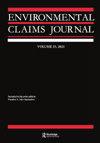Editor’s Note
Q3 Environmental Science
引用次数: 0
Abstract
Too many companies face significant financial exposure by not having the right insurance in place when there is an environmental claim. General liability insurance policies and property policies exclude most fact patterns involving alleged or actual environmental or pollution damages. The decision to leave a gap in insurance and self-insure environmental exposures should be a thoughtful one, particularly when there are more emerging cancer-causing chemicals being studied and regulated, and a greater variety of detection equipment are being utilized. My 2019 Environmental Claims Journal Editor’s Note addressed emerging contaminants 1,4 Dioxane, and Perfluoroalkyl substances (PFA’s) now the topic of a current movie Dark Waters, resulting in much more expensive remedial investigations and cleanups. The New York State Department of Environmental Conservation (NYSDEC) announced in 2019 they are requiring testing for this new class of chemicals for projects under NYSDEC’s supervision. In the past two years, New York State has set aside over $500 million to upgrade water treatment systems to include an Advanced Oxidation Process because these contaminants are, unfortunately, already in our drinking water. On December 9, 2019, Governor Cuomo approved legislation eliminating the sale of products containing 1,4-dioxane in New York State. Prior studies by the USEPA estimated more than 25,000 prior dry cleaners had used perc/PCE which contaminated the dry cleaner’s site and neighboring properties. One tablespoon of PCE is enough to contaminate two Olympic-sized swimming pools. Pending toxic tort litigation often involves vapor intrusion from solvents such as PCE to the neighboring residences, schools and other buildings which are located above the soil and groundwater plumes. The spillage of solvents was common from storage leaks, transfers, equipment failures, septic systems and sewers, and improper waste disposal in backyards and dumpsters. While PCE testing and remediation is ongoing, numerous other contaminants are regularly detected in the process creating liability disputes among property owners. For many large and small clients’ environmental liabilities have caused severe financial losses and some public relations disasters. In the past couple of years, we continue to experience claims frequency for asbestos exposures, fuel spills, mold contamination claims, lead ingestion and lead dust, carbon monoxide, legionella, sick building indoor air quality, vapor intrusion, chemical releases, silica and dust, PCBs, leaking sewer lines, midnight dumping of hazardous materials, and often offsite disposal based on waste manifests. In addition, a concern exists by many insureds, more than ever, regarding the intentional release of a bioterrorism agent, which can be a virus or bacteria, as there are more than 45 bioterrorism agents identified by the U.S. Center for Disease Control. The environmental insurance marketplace has evolved to cover the gap and provide specialized environmental policy forms for different sectors including health care, hospitality, universities and entertainment venues, oil and gas, contractors, mixed real estate portfolios, and even for manufacturing and distribution businesses.Editor’s音符
当有环境索赔时,太多的公司由于没有适当的保险而面临重大的财务风险。一般责任保险单和财产保险单不包括大多数涉及指称的或实际的环境或污染损害的事实模式。在保险和自我投保环境风险方面留下空白的决定应该是一个深思熟虑的决定,特别是当越来越多的新出现的致癌化学物质正在被研究和监管,越来越多的检测设备正在被使用。我的2019年《环境索赔杂志》编者按讨论了新出现的污染物1,4二恶烷和全氟烷基物质(PFA),现在是当前电影《黑暗水域》的主题,导致更昂贵的补救调查和清理。纽约州环境保护部(NYSDEC)于2019年宣布,他们要求对NYSDEC监督下的项目进行这类新化学品的测试。在过去的两年里,纽约州已经拨出5亿多美元用于升级水处理系统,包括高级氧化过程,因为不幸的是,这些污染物已经存在于我们的饮用水中。2019年12月9日,Cuomo州长批准了一项立法,禁止在纽约州销售含有1,4-二恶烷的产品。美国环保署先前的研究估计,超过25,000家干洗店使用过全氯乙烯,污染了干洗店的场地和邻近的物业。一汤匙的PCE足以污染两个奥运会规格的游泳池。悬而未决的有毒侵权诉讼通常涉及溶剂(如PCE)对邻近住宅、学校和其他建筑物的蒸汽侵入,这些建筑物位于土壤和地下水羽流之上。溶剂的泄漏很常见,包括储存泄漏、转移、设备故障、化粪池系统和下水道,以及后院和垃圾箱中的不当废物处理。虽然PCE测试和补救正在进行中,但在此过程中经常检测到许多其他污染物,从而导致业主之间的责任纠纷。对于许多大大小小的客户来说,环境责任已经造成了严重的经济损失和一些公关灾难。在过去的几年里,我们继续经历石棉暴露,燃料泄漏,霉菌污染索赔,铅摄入和铅尘,一氧化碳,军团菌,室内空气质量,蒸汽侵入,化学物质释放,二氧化硅和粉尘,多氯联苯,下水道泄漏,午夜倾倒有害物质,以及经常根据废物清单进行非现场处理的索赔频率。此外,许多被保险人比以往任何时候都更加担心故意释放生物恐怖主义制剂,这种制剂可以是病毒或细菌,因为美国疾病控制中心确定的生物恐怖主义制剂超过45种。环境保险市场已经发展到弥补这一差距,并为不同部门提供专门的环境政策形式,包括医疗保健、酒店、大学和娱乐场所、石油和天然气、承包商、混合房地产投资组合,甚至为制造和分销企业。
本文章由计算机程序翻译,如有差异,请以英文原文为准。
求助全文
约1分钟内获得全文
求助全文
来源期刊

Environmental Claims Journal
Environmental Science-Management, Monitoring, Policy and Law
CiteScore
2.20
自引率
0.00%
发文量
10
期刊介绍:
The Environmental Claims Journal is a quarterly journal that focuses on the many types of claims and liabilities that result from environmental exposures. The ECJ considers environmental claims under older business insurance policies, coverage and claims under more recent environmental insurance policies, as well as toxic tort claims. Exposures and claims from all environmental media are considered: air, drinking water, groundwater, soil, chemicals in commerce and naturally occurring chemicals. The journal also considers the laws, regulations, and case law that form the basis for claims. The journal would be of interest to environmental and insurance attorneys, insurance professionals, claims professionals, and environmental consultants.
 求助内容:
求助内容: 应助结果提醒方式:
应助结果提醒方式:


